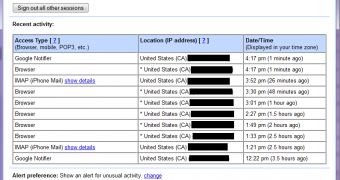Email and social media accounts have become highly valuable for cybercriminals because they can utilize them to ensure that their malicious campaigns record a higher rate of success. Many internauts have learned to avoid notifications coming from unknown sources, but they still tend to trust messages coming from friends and acquaintances.
Scambook experts have issued an advisory to teach users how to tell if their Facebook, Twitter of Gmail accounts have been overtaken by hackers.
Gmail and other email client customers should know that their accounts have been hijacked in case they notice one day that they can’t log in with their passwords. This most likely means that someone has taken over the account and changed its password.
The account activity section could also reveal the signs of misuse. If you live in the US, you shouldn’t see any sessions from other countries or other states than your own.
Finally, check your “Sent Mail” folder to see if someone else has been busy sending out malware-infested emails on your behalf.
The percentage of utilized storage capacity is always a good place to look. Gmail users can check out the usage in the lower left corner of the window. If too much space is used up, it could mean that a large number of spam messages have been sent out to your contacts.
With Twitter it’s somewhat easier. If you see any tweets, direct messages you didn’t post, or applications you haven’t installed, your account has most likely been hacked.
Also, when cybercriminals take over Twitter profiles, they usually follow a lot of random users, so this could be another sign of malicious activity.
As far as Facebook is concerned, taking a look at the active sessions in the Security Settings section could always be of great aid in identifying illegal logins.
Similar to Twitter, suspicious activities in the newsfeed and timeline should also tell you that someone has been using your account to advertise a malicious file or website.
Finally, in case your credit card information is on file and you’re in the habit of using Facebook credits to make purchases, take a look at the apps you have bought.
If you notice any of these signs, be sure to change your password, revoke all malicious apps if necessary, and make sure that your security software is up to date.
Also, remember that most services provide special pages for customers whose accounts have been overtaken by hackers.

 14 DAY TRIAL //
14 DAY TRIAL //